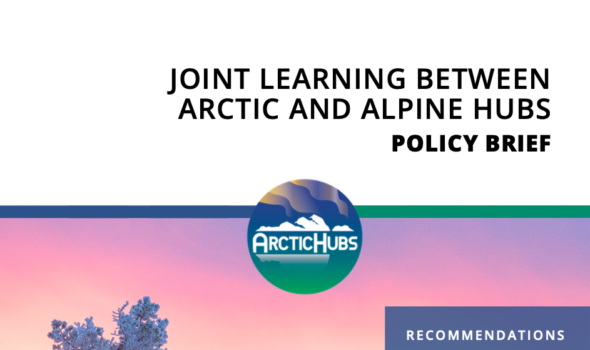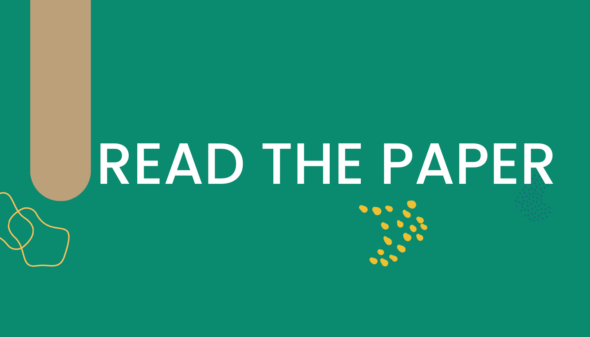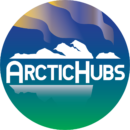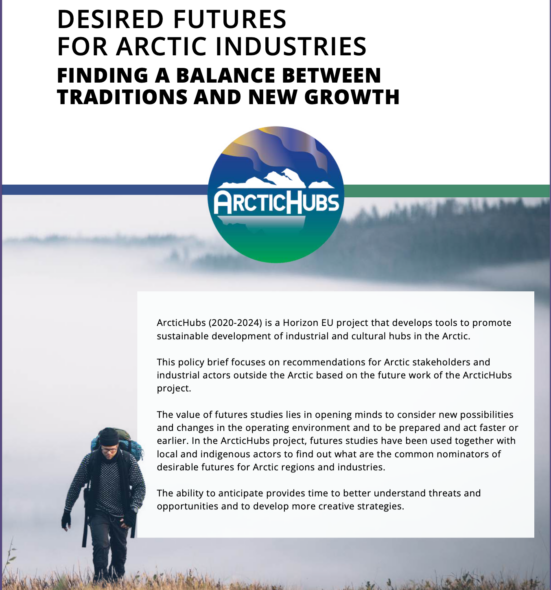Policy briefs
This policy brief – Future Scenarios for Arctic Industries – by Tuulentie, S., Rikkonen, P., Rikkonen, T., Inkilä, E., Lyngee-Pedersen, K., Lidestav, G., Sandström, P., Sandström, S., Iversen, A., Robertsen, R., Bogadóttir, R., Vang, E., Ólafsdóttir, R., Edvardsdóttir, A.G., Bishop, M.V., Miettinen, J., & Rautio, P. presents recommendations for Arctic stakeholders on future scenarios for sustainable industrial development. Based on futures studies involving local and indigenous actors, it highlights the importance of balancing traditional livelihoods and industrial growth, ensuring community involvement in decision-making, and promoting sustainable practices across key industries such as tourism, forestry, aquaculture, and mining. [here].
The policy brief – Joint learning between Arctic and Alpine hubs – by Riccardo Beltramo, Astrid Maria Cabrera, Marco Giardino, Helge Flick, and Jukka Teras provides key findings and recommendations on enhancing sustainable development through community engagement, economic diversification, and collaborative platforms. For a detailed analysis of policy outcomes, read the full policy brief [here].
Publications
Journal of Land Use Science, Volume 19, Issue 1 (2024)
Edited by Ivana Zivojinovic, Pasi Rautio, Jerbelle Elomina Download the full Journal from here.
Exploring land use conflicts arising from economic activities and their impacts on local communities in the European Arctic (2024)
I. Živojinović a,b,c*, J. Elomina a,b*, H. Pülzld, K. Calanasana,I. Dabića,b, R. Ólafsdóttire, S. Siikavuopiof, A. Iversenf, R. Robertsenf,J. Bjerkeg, S. Engeng, H. Tommervikg, R. Bogadóttirh, S. Moiolii,S. Tuulentiei, P. Rautioi, K.e Lynge-Pedersenj, G. Lidestavk,A. Guðrún Edvardsdòttirl and V. Nygaard, 2024, Journal of Land Use Science 19:1, P: 186-210, DOI: https://doi.org/10.1080/1747423X.2024.2382676
The paper explores the land use conflicts arising from economic activities in the European Arctic and their impact on local communities, particularly indigenous groups like the Sámi. The region, often seen as pristine, is undergoing significant growth driven by resource extraction industries such as mining, forestry, fish farming, and tourism. These activities, while economically beneficial, often lead to conflicts with traditional livelihoods, especially reindeer herding, and pose environmental and cultural challenges. The study, conducted across 15 hubs in five European Arctic countries, highlights the need for more localized assessments of socioeconomic impacts, as current evaluations are typically conducted at a macro level. The findings emphasize the importance of balancing economic growth with the preservation of indigenous cultures and sustainable development practices.
Download the paper from here. 
Geopolitical tensions framing different industries in the EuropeanArctic: aquaculture, forestry, mining, and tourism in question (2024)
L. Suopajärvia, J. Tikkanena, A. G. Edvardsdóttirb, S. Engenc, E. Inkiläd, A. Iversene, V. Nygaardf and R. Ólafsdóttir, 2024, Journal of Land Use Science 19:1, 170-185, DOI:10.1080/1747423X.2024.2362733
The paper examines how geopolitical tensions, particularly those involving Russia, China, and the USA, have influenced the development of key industries in the European Arctic, namely aquaculture, forestry, mining, and tourism. Through qualitative analysis of 60 interviews, the study reveals that state power, security concerns, and international relations significantly shape economic activities in these sectors, with an increasing focus on state actors’ interests in the region’s natural resources and physical space. Download the paper from here. 
Arctic cruise tourism and social license to operate: exploring social acceptance and trust in cruise tourism
R. Ólafsdóttira, R. Bogadóttirb, J. Karkut, Johannes T. Wellinga, S. Tuulentied, A. G. Edvardsdòttire, E. Pállsdóttir Vangb and A. Karlsdóttir, 2024. Journal of Land Use Science 19:1, 170-185, DOI:10.1080/1747423X.2024.2362733
 The paper examines the impact of increased Arctic cruise tourism on local communities, evaluating the feasibility of Social License to Operate (SLO) by analyzing attitudes and trust. Findings show economic concerns dominate, with mixed acceptance levels and the need for better communication among stakeholders. Download the paper from here.
The paper examines the impact of increased Arctic cruise tourism on local communities, evaluating the feasibility of Social License to Operate (SLO) by analyzing attitudes and trust. Findings show economic concerns dominate, with mixed acceptance levels and the need for better communication among stakeholders. Download the paper from here.
Industry-specific impacts of global drivers in the European Arctic
V. Nygaard, S. Engen, L. Suopajärvi, A.G. Edvardsdóttir, A. Iversen, R. Bogadóttir, S. Tuulentie, J.W. Bjerke, P. Rautio, J. Elomina & J. Miettinen, 2024, Journal of Land Use Science, 19:1, 150-169,
DOI: 10.1080/1747423X.2024.2358951
 The paper examines how global trends influence key natural resource-based industries in the European Arctic, specifically aquaculture, forestry, mining, and tourism. The study identifies eight major global drivers affecting these industries, highlighting the importance of strategic planning and collaboration among stakeholders to address the unique challenges and opportunities in this region. Download the paper from here.
The paper examines how global trends influence key natural resource-based industries in the European Arctic, specifically aquaculture, forestry, mining, and tourism. The study identifies eight major global drivers affecting these industries, highlighting the importance of strategic planning and collaboration among stakeholders to address the unique challenges and opportunities in this region. Download the paper from here.
Between the local and the global? Reindeer herders’ perspectives on land use challenges and conflicts in the Sámi homeland, Finland
M. T. Turunen, T. Rikkonen, A. Nikula, S. Tuulentie & P. Rautio, 2024, Journal of Land Use Science, 19:1, 150-169, DOI: 10.1080/1747423X.2024.2358951
 The paper explores how various land uses impact reindeer herding in Inari, Finland. Through a Public Participation GIS survey, it highlights the herders’ concerns about predators, tourism, hunting, and forestry, emphasizing the cumulative negative effects on their traditional livelihoods and suggesting that new land uses should be directed to existing population centers rather than grazing areas. Download the paper from here.
The paper explores how various land uses impact reindeer herding in Inari, Finland. Through a Public Participation GIS survey, it highlights the herders’ concerns about predators, tourism, hunting, and forestry, emphasizing the cumulative negative effects on their traditional livelihoods and suggesting that new land uses should be directed to existing population centers rather than grazing areas. Download the paper from here.
Systematic Literature Review of Land Use Conflicts in Northern Sweden—Lessons Learned and Ways Forward
J. Elomina, I. Živojinović, Resources 2024, 13, 77, DOI: https://doi.org/10.3390/resources13060077
 The paper provides a comprehensive review of land use conflicts in Northern Sweden driven by the global demand for resources and the green transition. It identifies three main types of conflicts—access, development, and management—and suggests inclusive, participatory approaches and broader stakeholder understanding to effectively address these issues. Download the paper from here.
The paper provides a comprehensive review of land use conflicts in Northern Sweden driven by the global demand for resources and the green transition. It identifies three main types of conflicts—access, development, and management—and suggests inclusive, participatory approaches and broader stakeholder understanding to effectively address these issues. Download the paper from here.
Lean forestry – A paradigm shift from economies of scale to precise and sustainable use of ecosystem services in forests
P. Rautio, H. Lideskog , U. Bergsten , M. Karlberg, 2023. Forest Ecology and Management (530)120766
Lean forestry is a novel philosophy of forestry practise that aims to direct the idea of “big is beautiful” in modern silviculture more into “do cost effectively only what is needed to fulfil the goals”. This kind of a paradigm shift requires systems with new kinds of abilities to remotely sense the surrounding environment. Download here.
Multiple-use forests and reindeer husbandry – Case of pendulous lichens in continuous cover forests
T. Rikkonen, M. Turunen , V. Hallikainen , P. Rautio, 2023. Forest Ecology and Management (529)120651
This study shows that in order to better reconcile forestry and reindeer husbandry in a reindeer herding area, the larger trees should be saved, and the cutting cycle should be kept as long as possible. In addition, lichen-rich areas should be excluded from logging, and the access of reindeer to those areas should be secured. Download the paper here.
Reports
Global economic drivers in the development of different industrial hubs in the European Arctic
Work package 1 – ArcticHubs report
The European Arctic (EA) is increasingly affected by globalization, which consists of various global megatrends impacting all industries and communities. This report analyses global drivers affecting key industries—aquaculture, mining, forestry, and tourism. The study provides a cross-industry perspective, examining the implications of global economic trends on local hubs in the EA, aiming to understand their future pathways and sustainability challenges. Researchers have carried out almost 70 interviews and examined several national industry-specific strategies and relevant EU strategies.
D1.2 Global economic drivers in the development of different industrial hubs in the European Arctic
Analyses of the corporate social responsibility of international companies operating in the Arctic
Work package 1 – ArcticHubs report
The report investigates how companies in different resource-based industries (i.e., aquaculture, tourism, mining, and forestry) understand their corporate social responsibility (CSR) in the context of their business operations in the Arctic. Researchers have analysed the sustainability reports and/or annual reports and corporate websites of 17 companies and associations from the aquaculture, tourism, mining, and forestry sectors that are active in several Arctic hubs included in the project.
D.1.2 – Subtask 1.1.3. Analyses of the corporate social responsibility reporting of the main international companies operating in different Arctic hubs: sustainable development in focus
Analysis of climate change impacts in different industries and hubs
The aim of the report is to analyse the meaning of climate change as a global driver for different industries and hubs. The data comes from national climate change and climate
change adaptation plans, national Arctic strategies, industry strategies as well as interviews of key informants. The report also looks at challenges that are simply too complex and uncertain to concretize hence remain as suggestions. As developing co-knowledge is at the core of the ArcticHubs project, this deliverable is data-driven and not based on previous academic literature.
Work package 1 – ArcticHubs report
D.1.4 Climate change impacts in different industries and Arctic hubs
Political drivers for development of different industries in the European Arctic
D1.3 report examines the geopolitical tensions and factors influencing the development of key industries in the European Arctic, including aquaculture, forestry, mining, and tourism. The analysis is based on national Arctic strategies from European Arctic states and relevant EU strategies, as well as 60 interviews with industry specialists. The report applies both classical and critical geopolitical approaches to investigates its questions: 60 interviews were carried out to explore how geopolitics can affect the development of different industries and how informants related to these industries understand their operations in the Global North.
Work package 1 – ArcticHubs report
D1.3 Geopolitical tensions and drivers of different industries in the European Arctic
Changes in the Arctic environment as a result of hub activity
This report examines the environmental changes in the Arctic due to hub activities, including forestry, aquaculture, tourism, mining, and indigenous practices. The report focuses on issues such as habitat fragmentation, biodiversity loss, and pollution caused by these activities across 18 hubs in Norway, Sweden, Finland, Iceland, Greenland, and beyond. It highlights the interactions between hub activities and their cumulative impacts, providing foundational knowledge for sustainable development strategies within the ArcticHubs project.
Work package 2 – ArcticHubs report
D2.3: Changes in the Arctic environment as a result of hub activity
Changes in the Arctic environment due to climate change
This report summarizes the effects of climate change on ecosystems, industries, and indigenous livelihoods in the European Arctic. Based on new data analyses and literature, it covers the rapid changes in temperature, sea ice extent, and growing seasons, and their impacts on reindeer husbandry, fish farming, forestry, mining, and tourism. The report provides climate projections for the 21st century, highlighting the expected challenges for Arctic communities in adapting to these changes.
Work package 2 – ArcticHubs report
D2.4: Changes in the Arctic environment due to climate change
DPSIR Framework Analysis
This report applies the Driver–Pressure–State–Impact–Response (DPSIR) framework to 17 Arctic hubs to assess the environmental impacts of forestry, aquaculture, mining, tourism, and indigenous activities. The analysis identifies key drivers, pressures, and resulting environmental changes and impacts, providing a structured approach to help understand and mitigate adverse effects. The findings emphasize the importance of “glocal” (local and global) responses to create sustainable pathways for Arctic communities and industries.
Work package 2 – ArcticHubs report
D2.5: DPSIR Framework: Analysis of drivers, pressures, state, and impact of economic activities in the Arctic environment
Effects of economic activities on local societies and cultures
D3.2 report focuses on the impacts of both new and existing industries on the social, economic, and cultural structures of local communities in the European Arctic. The economic activities analyzed include forestry, mining, fish farming, tourism, and indigenous activities. Using an exploratory and descriptive research method, the report provides a comprehensive analysis of how these activities influence local hubs. It highlights both the opportunities created, such as job growth and improved infrastructure, and the challenges, including environmental impacts and power imbalances, emphasizing the importance of effective stakeholder participation and cross-sectoral communication for sustainable development in the Arctic.
Work package 3 – ArcticHubs report
D3.2: Context and effects of existing and new economic activities on local societies and cultures
Synthesis report on socio-cultural effects
This report offers a comparative analysis of socio-cultural effects of economic activities in the European Arctic, examining sectors like fish farming, forestry, mining, tourism, and indigenous activities. Utilizing expert interviews and surveys, it explores local perspectives and cross-comparative insights with selected Alpine regions to understand socio-cultural impacts, development dynamics, and policy implications for sustainable Arctic development.
Work package 3 – ArcticHubs report
D3.4: Synthesis report comparative analysis on socio-cultural effects
Final version of RenGIS
This document describes the final version of RenGIS (Reindeer GIS), a participatory GIS system developed to support Sami communities in using and managing reindeer husbandry plans. RenGIS 3.0 includes new features such as a mobile app for field data collection, improved inventory methods, and visualization tools. The system allows herders to gather geospatial data and collaborate with other land users to resolve land-use conflicts, serving as a vital tool for local community involvement in sustainable development.
Work package 4 – ArcticHubs report
D4.6: Final version of RenGIS with improved data collection methods and data visualization
Practical solutions to land use issues for each hub
This report documents practical solutions to land and sea use conflicts in the Arctic, utilising various participatory tools and methods. It highlights the application of tools such as Maptionnaire, RenGIS, CodGIS, and serious games to engage stakeholders and develop collaborative solutions. The outcomes of using these participatory tools across different hubs are summarized, focusing on how they have helped mitigate conflicts among industries, local communities, and indigenous stakeholders.
Work package 4 – ArcticHubs report
D4.7: Described and communicated practical solutions to land use issues for each hub
Future policy actions
This document provides a roadmap for policy actions in Arctic hubs based on future scenarios and workshops held with stakeholders. Recommendations focus on balancing industrial growth with environmental sustainability, enhancing local community participation, and supporting indigenous livelihoods. The aim is to guide decision-making towards a more sustainable and inclusive future for Arctic regions, with specific suggestions for tourism, aquaculture, mining, forestry, and other key industries.
Work package 5 – ArcticHubs report
D5.5: Future policy actions
Social License to Operate (SLO) Guidelines
This handbook provides guidance for Arctic industries and decision-makers on implementing a Social License to Operate (SLO). It covers strategies for gaining local community acceptance and trust, focusing on industries like mining, aquaculture, forestry, and tourism. The handbook emphasizes adapting SLO models to specific Arctic contexts, respecting indigenous rights, and balancing economic benefits with environmental and social impacts to ensure sustainable industrial development.
Work package 5 – ArcticHubs report
<h5 Handbook for Social License to Operate in Arctic Industries

